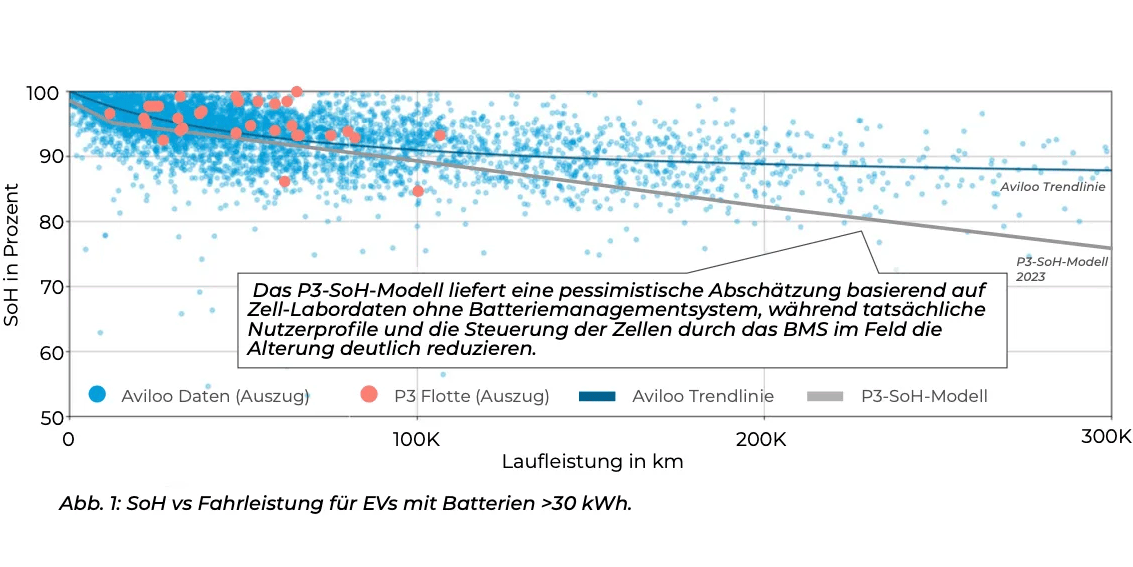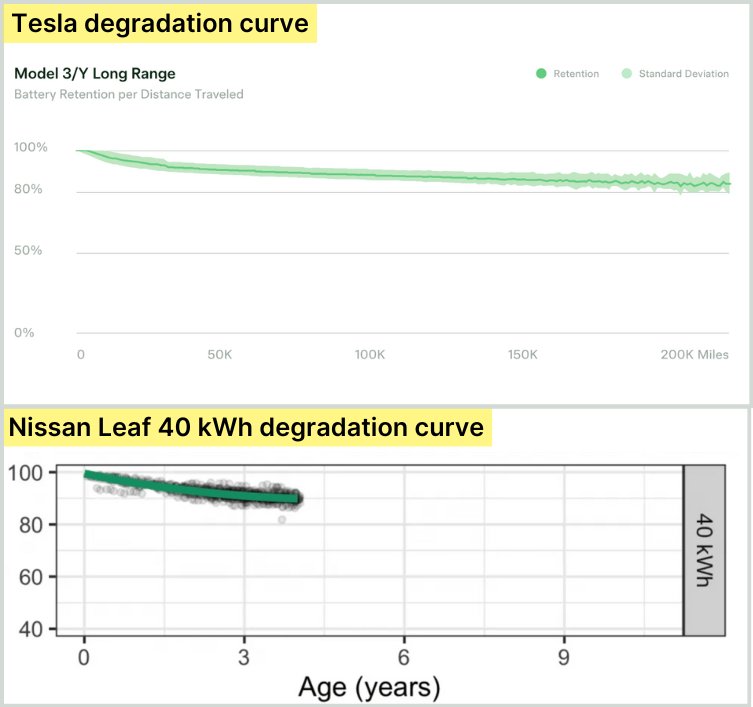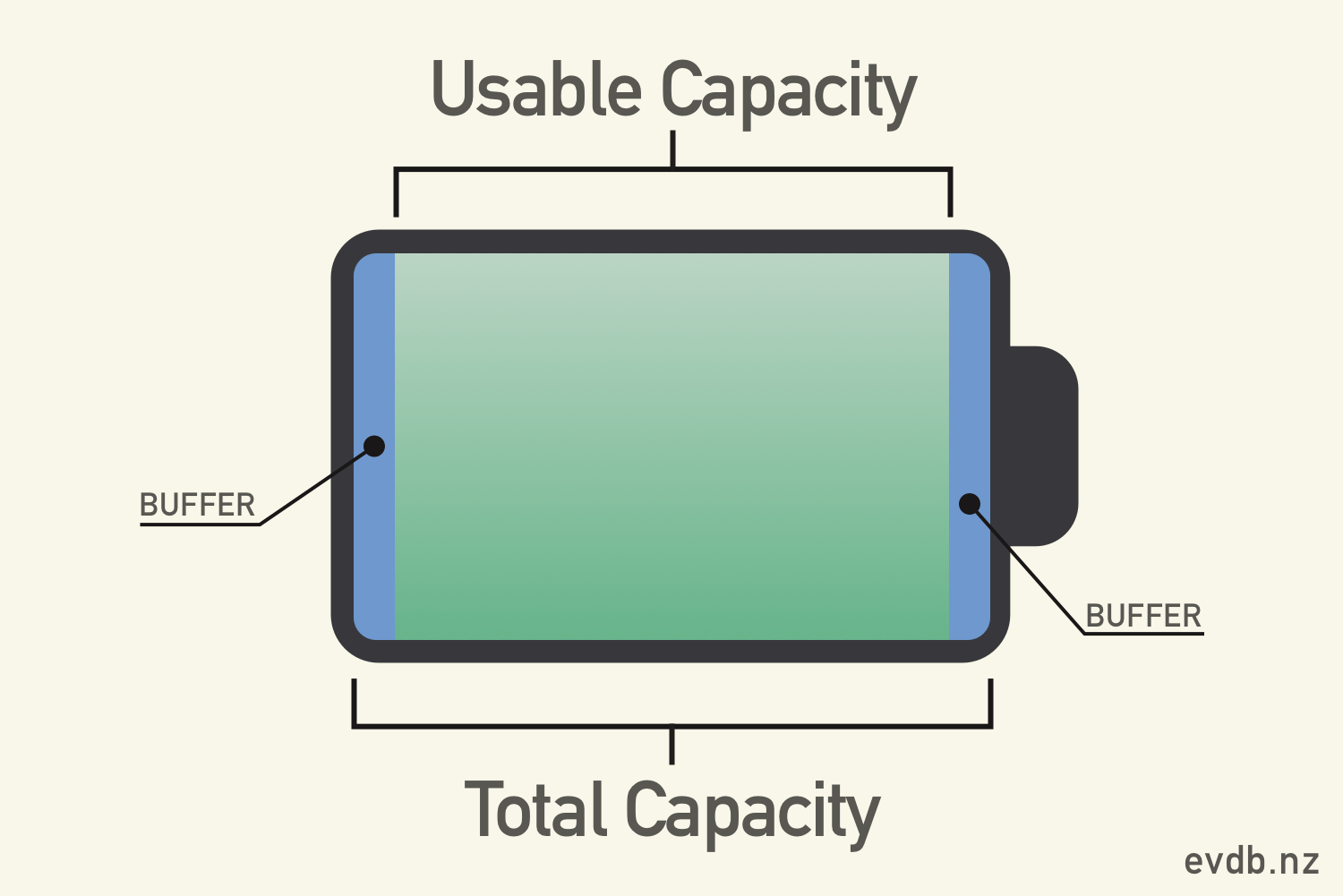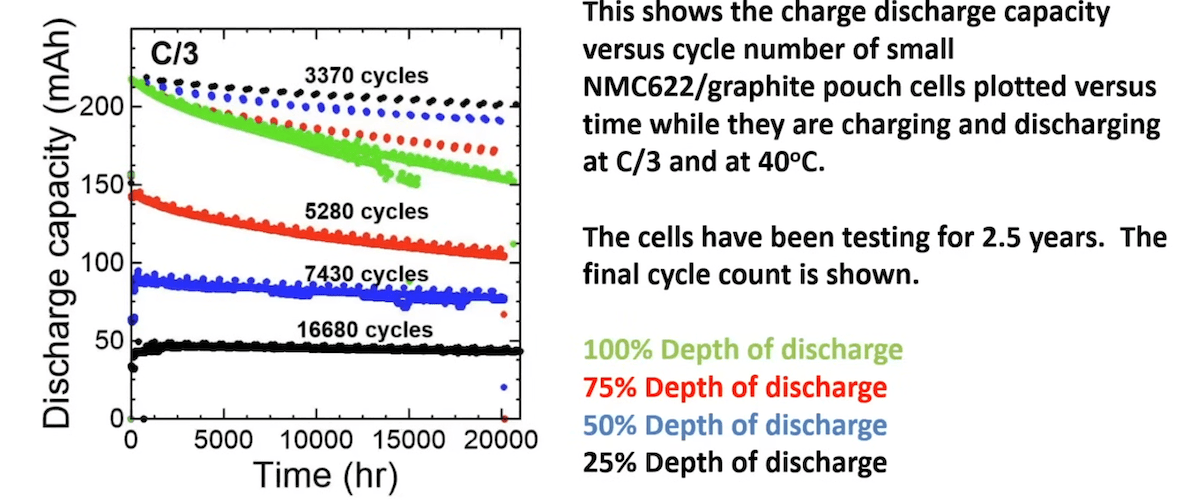When Will Your EV Battery Need Replacing?
The battery is one of the most expensive parts of an EV. Will you need to replace it?

When we think of a battery, we tend to think of :
-
The 12-volt lead-acid battery that sits under the bonnet of all our cars (the one that seems to fail us at the worst possible moment).
-
The battery in our phone (that after a few years seems to run out of charge in mere hours).
An EV battery is far more sophisticated, featuring a high-tech management system and active thermal control.
How long will an EV battery last? Honest answer: We don’t (yet) know.
Almost all EV batteries are still in the vehicle. However, we have two great sources of info to help us predict:
-
Telematics data from organisations that record data from thousands of EVs (as they are driven).
-
Extensive lab research and testing of lithium-ion battery cells.
Will my battery need replacing?
There’s a major distinction between early electric cars (2011-2016) and newer cars (2016+).
US research shows that only 1% of newer cars have had battery replacements [1] (which were under warranty). Outside of this 1%, some vehicles have had recalls.
(It's likely that this percentage may be even lower for NZ due to the different EV models that comprise our fleet.)
In New Zealand, those early cars are mostly the Nissan Leaf - one of the first EVs to market. NZ imported thousands of these (second-hand) from Japan.
The battery is covered by warranty
All new EVs have a battery warranty (typically 7-8 years) covering any battery failure.
What about after this, and the loss of battery capacity?
How do lithium-ion batteries lose capacity?
Lithium-ion (Li-ion) batteries have different chemistries - indicating the elements used in the positive electrode (cathode).
An EV battery pack comprises modules, which in turn are made up of cells.
Lithium batteries lose capacity over time, depending on how they are used. For EVs, battery capacity dictates how far you can travel on a single charge.
However, the way the battery is maintained can significantly lengthen its lifespan.
There are two ways the battery loses its capacity.
Li-ion cells lose capacity during storage (NMC chemistry)
Extensive lab testing shows a battery loses capacity if stored at high temperatures (> 30 degrees) and in a highly charged state [2]. When the voltage is higher, the positive electrode is more reactive to the electrolyte in the cell.
This is called calendar aging.
Li-ion cells lose capacity during the charge-discharge cycle
Cells lose capacity more quickly when charged and discharged over extended depth of discharge ranges.
This is called cycle aging.
How to prevent: Lots of short drives, followed by charging are better than long drives with infrequent charging.
Long drives are fine. But charge when you can. EVs are meant to be driven!
Best practice: Charge your car every night after driving, instead of waiting for the battery to get low before recharging.
How much does depth of discharge make a difference?
Lab test results of an NMC622 cell (22,000 hours of continuous charging and discharging):
-
Cells that did the majority of their cycling at 25% DoD lost only 8% of capacity.
-
Cells that were cycled at 100% DoD lost 27% of capacity.
Some Li-ion cells lose capacity when continually charged to 100%
As a battery becomes full, the voltage increases. Testing of various Li-ion cells (particularly those with a high nickel content, such as NMC 811) shows a volume change in the cell at higher voltages [3].
This results in capacity loss, so charging to 75-80% most of the time is good practice for NMC batteries. LFP is slightly different (see below).
So, if you can, set a charging limit of 75-80%. Charge to 100% when you are going on a longer trip.
If you own a Nissan Leaf (of any kind) - this is very important. A comprehensive test of 24 Leaf batteries showed considerably increased degradation when charged to 100%: "if the driver takes good care of the car, the battery degradation speed could be reduced by half." [13]
What is the real-world data telling us?
-
Tesla data (from Recurrent - USA) shows that, after 5 years, a Model 3 has lost 8% of capacity, but this is not linear. As with other testing, there is an initial loss (about 6%) before stabilisation [1].
-
The Tesla 2023 impact report shows that after 320,000 km (200,000 miles), Model Y/3 lost 15% of its capacity, and Model S/X lost 12% [6].
-
An updated report (2024) from fleet telematics company Geotab shows batteries degrading at 1.8% per year.
-
Research from P3 Group (German) confirms degradation is not as bad as feared [11]. Their dataset of 7,000 vehicles shows a loss of 5% capacity (after 30,000 kms). Then a slowing of degradation; 90% SoH at 100,000 kms. [10]
-
A comprehensive study from Stanford [12] shows that cycle aging is not as bad as first thought: "We found that [...] dynamic cycling enhances battery lifetime". In other words: EV batteries are doing better under our normal driving conditions than the lab testing suggests.
Battery degradation is not linear
P3 Group (German): The blue line shows the trendline of actual batteries in cars. The grey trendline is P3's original model based on batteries in a lab. Showing that BMS's in cars are good at maintaining battery health.


From Tesla Impact report and FliptheFleet
What's the difference with LFP batteries?
An increasing number of EVs are using LFP chemistry.
- LFP (Lithium iron phosphate) cells have a longer cycle life than NMC (i.e. last even longer), and don’t suffer from the volume expansion that occurs with NMC cells at higher voltages (as the voltage stays lower in LFP) [4].
LFP best practice
-
Charge to 100% once per month*
Helps the vehicle to display the charge percentage accurately. -
When storing the car (for an extended length of time) - store at a lower state of charge (e.g. 50%)
A lower cell voltage means a longer-lasting battery. -
Operate at lower states of charge on average.
What's with number 3? Isn't it conventional advice for LFPs to charge to 100% all the time?
Newer research [7] suggests that cycling the LFP battery between 75% and 100% all the time will increase degradation. This seems to conflict with car makers' advice.
*Tesla and BYD recommend charging to 100% once per week.
The Ford Mustang Mach-E (LFP) manual says:
- Set the maximum charge level to 100% and charge to 100% at least once per month to maintain range accuracy.
It's confusing but not conflicting: "Charge to 100% every now and then, but not all the time."
What can I expect from my EV battery?
The mounting evidence shows that modern lithium batteries will last a very long time.
It seems extremely unlikely that a new EV bought today would ever need its battery replaced (except for a fault).
-
Newer, larger batteries (60 kWh or greater) have a smaller depth of discharge, which leads to less degradation.
-
Manufacturers have sophisticated technology to manage heat (such as charging curves and active cooling).
What happens if the range gets lower and lower?
We’ve seen with the Leaf in NZ that owners upgrade to a newer car when the range no longer meets their needs.
Someone else is happy with a cheaper car that does less range.
We’ve also seen that when the range gets untenable (i.e. too low to be useful), the battery modules are sold as home storage, and a battery from a scrapped vehicle is put into the car.
However, it's clear that a robust system for battery end-of-life is required. Eventually, all battery cells will reach end-of-life and a financially prudent pathway for recycling is needed.
Can batteries develop faults?
Yes (although, anecdotally this seems rare). It highlights the need for upskilling in the automotive technician sector - to correctly diagnose faults - and minimise repair costs (could a module be replaced instead of an entire battery pack?).
How does battery health affect the EV's value?
Evidence from the Nissan Leaf shows that battery health is correlated with the car's resale value.
A Leaf with a battery State of Health (SoH) of 70% is worth less than a car with an SoH of 87%.
Right now, New Zealand lacks an independent nationwide battery certification process.
Many other countries have these systems in place (such as Altelium and Aviloo). This allows battery health certificates to be issued for any EV - providing certainty to buyers and insurers. UK research shows buyers are prepared to pay more for a secondhand EV that has an independent battery health certificate.
What is 'usable' battery?
Manufacturers list battery capacity as either gross (total) or net (usable).
This is confusing as some makers don't state which is which.
-
Gross (total) - the complete capacity.
-
Net (usable) - how much capacity the vehicle is allowed to access.
Why the difference?
To maintain lithium-ion batteries in good condition, they should not be allowed to be empty (0% charge) or full (100% charge). Note that charging to 100% in a LFP is not considered to be an issue.
This buffer also maintains capacity despite degradation (i.e., the artificial buffer gets smaller as the battery degrades).

How does this work? And why?
The vehicle maintains an artificial buffer (around 2-5% of total capacity) that prevents the driver from completely draining or fully charging.
Sophisticated electronics manage this 'buffer' called the Battery Management System (BMS).
Even though your dashboard might say 100% - there is still some room in the battery.
When your battery seems empty, more electricity remains. Most EVs will go into 'snail mode' to prevent the battery from completely draining. Snail mode severely restricts speed to avoid stranding.
The BMS also monitors the voltage of every cell and the temperature of the battery pack, adjusting peak power delivery where necessary.
What are the pros and cons of LFP and NMC?
| Chemistry | Pros ✅ | Cons ❌ |
|---|---|---|
| NMC | More energy dense (longer range for same size battery). | More expensive |
| LFP | Longer lifespan (slower degradation) | Less energy dense (shorter range for same size battery). |
Sodium-ion vs Lithium-ion
Sodium-ion batteries are coming on the market (you can already buy AA cells).
It will take some time before production efficiencies lead to lower prices, but we can expect them in energy storage systems and entry-level EVs (maybe).
Sodium-ion Pros and Cons
-
Good power density (high charge and discharge rates)
-
Can be fully discharged without damaging cycle life (great for shipping)
-
Safe
-
Low volumetric energy density (cells are much larger for the same amount of energy.
-
Sodium is an abundant mineral.
-
Probable use: energy storage and low-range EVs.
References
-
Recurrent Auto: How long do batteries last? (ref)
-
Ecker, M., Nieto, N., Käbitz, S., Schmalstieg, J., Blanke, H., Warnecke, A., & Sauer, D. U. (2014). Calendar and cycle life study of Li (NiMnCo) O2-based 18650 lithium-ion batteries. Journal of Power Sources, 248, 839-851.
-
Bree, G., Hao, H., Stoeva, Z., & Low, C. T. J. (2023). Monitoring state of charge and volume expansion in lithium-ion batteries: an approach using surface mounted thin-film graphene sensors. RSC advances, 13(10), 7045-7054.
-
Preger, Y., Barkholtz, H. M., Fresquez, A., Campbell, D. L., Juba, B. W., Romàn-Kustas, J., ... & Chalamala, B. (2020). Degradation of commercial lithium-ion cells as a function of chemistry and cycling conditions. Journal of The Electrochemical Society, 167(12), 120532.
-
Extensive seminar from Dr Jeff Dahn - Professor in the Department of Physics & Atmospheric Science, Dalhousie University.
-
Tesla Impact Report 2023 (ref).
-
Zsoldos, E., Thompson, D., Black, W., Azam, S., & Dahn, J. R. (2024). The Operation Window of Lithium Iron Phosphate/Graphite Cells Affects their Lifetime. Journal of The Electrochemical Society. (see also explanation from Engineering Explained).
-
Geotab: 2024 battery degradation (ref).
-
FliptheFleet reported battery state of health for Nissan Leaf (ref).
-
P3 Group research (white paper)
-
Electrive - P3 research (ref)
-
Geslin, A., Xu, L., Ganapathi, D., Moy, K., Chueh, W., & Onori, S. (2024). Dynamic cycling enhances battery lifetime. (ref).
-
Gao, W., Cao, Z., Fu, Y., Turchiano, C., Kurdkandi, N. V., Gu, J., & Mi, C. (2024). Comprehensive study of the aging knee and second-life potential of the Nissan Leaf e+ batteries. Journal of Power Sources, 613, 234884. https://doi.org/10.1016/j.jpowsour.2024.234884
This graph from Dr Dahn shows how depth of discharge affects capacity. The cell was charged and discharged non-stop.
The black line (16680 cycles) shows charging and discharging 25% at a time. Then every so often, the cell is charged to full - showing the actual capacity (the black dots) — and so on for each colour.
It demonstrates the incredible lifetime of Li-ion cells.

